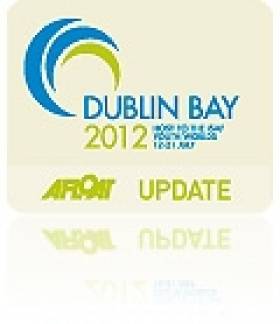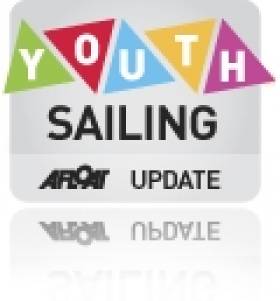Displaying items by tag: 29er
#dublinbay2012 – There will be host nation debuts in both the SL16 catamaran and 29er skiff classes at the 2012 Four Star Pizza ISAF Youth Worlds on Dublin Bay in ten days time.
Sean Donnelly and Tadgh Donnelly compete in the 29er and Alexander Rumball and Rory McStay go in the SL16 but as the championships is also set to welcome back 2011 gold medallists in both the SL16 and 29er the Irish crews have their work cut out.
Martin Lowy and Kim Andrade (BRA) head to Dublin to defend the SL16 title they comprehensively won in Zadar, Croatia last year whilst Spain's Carlos Robles and Florian Trittel (ESP) will be aiming to do the double.
The 15 strong SL16 fleet has the makings of an excellent competition with five of the six medallists at the 2011 ISAF Youth Worlds back again.
Lowy and Andrade blew the competition away in the light winds in Croatia that were prevalent at the start of the competition winning eight races in a row to set them up for the gold medal. When the big conditions came in the Brazilians finished mid-fleet as Danish twin brothers Nicolaj and Daniel Bjornholt Christiansen kicked it up a gear with four top two finishes.
The Danes comeback only proved enough for the silver medal as the Brazilians won by a seemingly comfortable margin of seven points.
The conditions in Ireland may suit the Bjornholt Christiansen's whose size will prove advantageous. Great Britain's Rupert White finished third with Nikola Boniface in 2011, he returns with Tom Britz.
In four years' time the Mixed Multihull will be on show at the Rio 2016 Olympic Sailing Competition following the selection of the Nacra 17. The Open SL16 event at this year's regatta features several mixed crews. Paul Darmanin and Lucy Copeland (AUS) are one of those in Dublin with Rio 2016 on their mind, "The mixed multihull for the Games is on our rader but I just want to focus on the Youth Worlds at the moment," said Darmanin who won SL16 gold in 2010 as crew with Chase Lurati.
"My cousin Jason and sister Lisa are training very hard working towards the 2016 Games so for me to try for the Olympics I would have to battle it out against them.
"Competing at the Olympic Games would be the ultimate dream come true as it is the highest level of sailing around. I love representing Australia so doing it at the Olympics would be fantastic."
New Zealand's Tomer Simhony finished fifth at the 2011 ISAF Youth Worlds in the SL16 with Ellie Copeland and is back again with another female crew, Gemma Jones. And the pair have considered their futures, "I think they [ISAF] made the right choice with the Nacra 17," said Simhony. "Gemma and I have discussed sailing together and will at least try to get a boat in the next two years and start a campaign. We'll see how it goes."
Twenty six teams will compete for 29er gold but the undermining favourites coming into the event are the 2011 Champions Carlos Robles and Florian Trittel (ESP). The Spaniards stormed to gold in Zadar, Croatia with a string of consistent results over 12 races to claim gold by 18 points.
With only Klaus Lange and Mateo Majdalani (ARG) returning from the top ten finishers in 2011, the Spaniards will aim for a second successive gold. Other returnees from 2011 include Paul Kohlhoff and Carolina Werner (GER), Varun Thakkar and Ganapathy Kelapanda (IND), as well as Alex Burger and Alex Lehtinen (RSA).
The fleet features a new wave of young sailors who will be seen beyond 2012 with 43 of the 52 sailors competing in the 26-boat fleet eligible to sail at the 2013 edition in Limassol, Cyprus. Belgium's Emile Van Holsbeke will be the youngest competitor in the 29er fleet at just 14-years-old. He will crew alongside Daan Vandormael.
Racing at the 2012 Four Star Pizza ISAF Youth Sailing World Championship begins on 14 July in Dun, Laoghaire, Ireland running until 20 July.
Youth Boat Selection Requires Leadership
There has been a call for the Irish Sailing Association (ISA) to take a lead in the big decisions that face youth sailors on what classes to sail to after they leave the ranks of the Optimist, Topper and Feva classes. The call comes from a leading junior organiser who does not wish to be named.
Although youth sailing is buoyant in Ireland it is known there is a 'high attrition rate' among teenagers. The lack of transfer in to senior dinghy classes has been a cause of concern for many clubs around the country.
The comments follow a recently published article on Afloat.ie promoting the RS 200 dinghy as a progression boat for juniors.
"We need a class that will keep youths engaged. The 420 and 29er are great boats but require higher levels of boathandling, are much more competitive and tend to attract the top sailors"
"While the ISA's Olympic ambitions are great to see, it will fail the sport as a whole if it does not tackle this gaping need, the organiser says.
Read the RS 200 article by Ciara Byrne and the junior organiser's comments here






























































